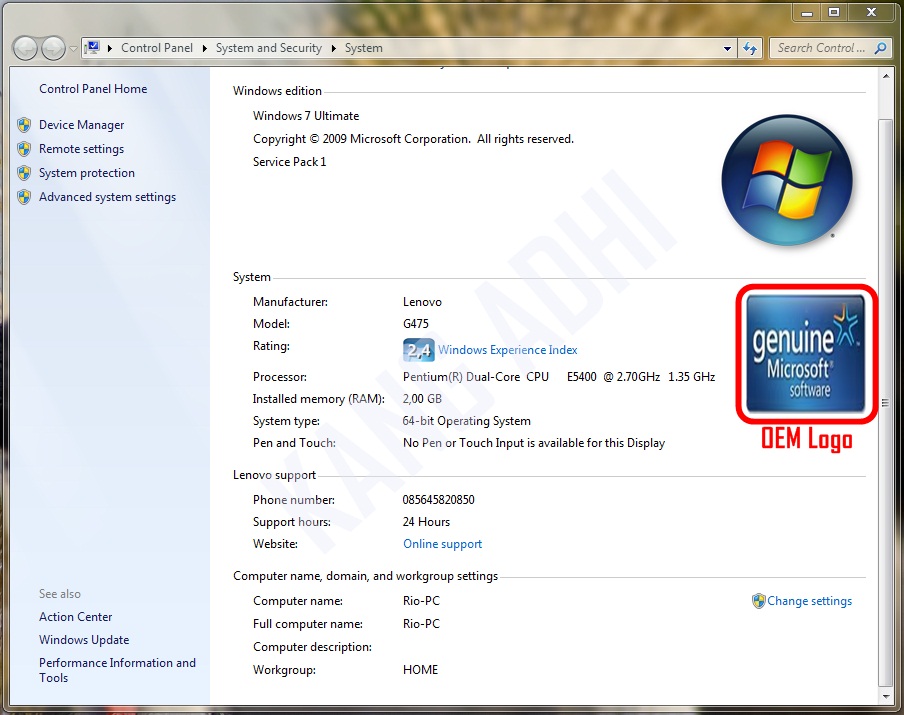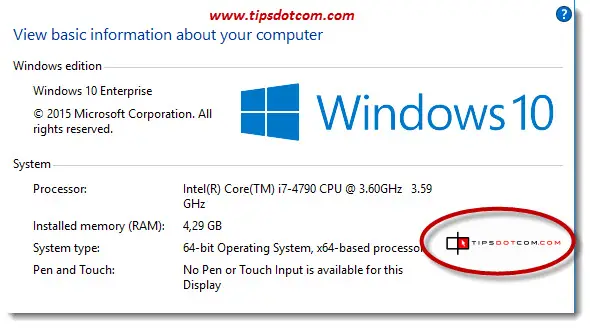If you bought your computer from and important retailer you might have observed that when you select Properties for 'My Computer' a logo and some information about that retailer is present.
By default, Windows do not provides any such information under the My Computer properties window unless it is edited by the retailer. So what is the OEM? OEM is the acronym for Original Equipment Manufacturer. Original equipment manufacturer is a company that builds products or components which are used in products sold by another company.
Computer manufacturers usually include their OEM brand info and logo in System Properties applet when preinstalling Windows. This article tells you how to add or modify the custom OEM information strings in the System Properties window in Windows Vista, 7, 8 and Windows 10.
- Download System Brand Changer - Change the system logo with a custom image and modify the OEM information in just seconds with this lightweight and portable application.
- Logo; Now its time to add Logo, the Default path for logo would be, C: Windows System32 oemlogo.bmp. Add your image with an extension of.bmp to the following directories, name your image with oemlogo.bmp and paste it to the system32 directory. However you can change the file location in registry key.
- In the Search the web and Windows field, type Programs and Features and either press Enter or tap or click Programs and Features to open it. In the Programs and Features window, click Turn Windows features on or off. In the Windows Features window, expand the Device Lockdown node, and check or clear the checkbox for Unbranded Boot.
Does your Windows show such information? If not, wouldn't it be cool to add your own information and logo? Yes, I know it would. But how can it be done because Microsoft did not supply any option regarding this issue? We will do a little tweak. The information does not need to be added to the registry. It is stored in an .INI file. You just need to create such a file.
Open the Notepad to create a new file. Inside place something similar to this:
[General]Manufacturer=Softpedia ComputerModel=TEST Seerivarum kaalai cut songs download.
[Support Information]Line1=Free downloads encyclopediaLine2=Line3=http://www.softpedia.comLine4=Line5=Windows, Games, Drivers, Handheld, Mac, Linux, Mobile, NewsLine6=
You can add any information to those lines. It's your option.Once you created this file save it in the format OEMINFO.INI and place it into the following folder: WindowsSystem32.
Next step is to create a logo. The logo must be in BMP format with 256 colors. Create/edit an image and save it OEMLOGO.BMP inside the above mentioned folder: WindowsSystem32.
Note that the logo won't work alone without the OEMINFO file. So it's mandatory to have both files placed inside the System32 folder. On the other hand, OEMINFO.INI can work without the logo, which is optional.
Before adding the OEM information.

 After the OEM information and logo has been added.That's all! Pretty simple, isn't it? More than that, you do not need to restart your computer either, because the information will be immediately collected by Windows and shown when you open My Computer properties. -->
After the OEM information and logo has been added.That's all! Pretty simple, isn't it? More than that, you do not need to restart your computer either, because the information will be immediately collected by Windows and shown when you open My Computer properties. -->You can suppress Windows elements that appear when Windows starts or resumes and can suppress the crash screen when Windows encounters an error that it cannot recover from. This feature is known as Unbranded Boot.
Important
The first user to sign in to the device must be an administrator. This ensures that the RunOnce registry settings correctly apply the settings. Also, when using auto sign-in, you must not configure auto sign-in on your device at design time. Instead, auto sign-in should be configured manually after first signing in as an administrator.
Requirements
Windows 10 Enterprise, Windows 10 Professional, or Windows 10 Education.
Terminology

Turn on, Enable: To make the setting available to the device and optionally apply the settings to the device. Generally 'turn on' is used in the user interface or control panel, whereas 'enable' is used for command line.
Configure: To customize the setting or sub-settings.
Embedded Boot Experience: this feature is called 'Embedded Boot Experience' in Windows 10, build 1511.
Custom Boot Experience: this feature is called 'Custom Boot Experience' in Windows 10, build 1607 and later. Articulate storyline 2 crack free download.
Turn on Unbranded Boot settings
Unbranded Boot is an optional component and is not enabled by default in Windows 10. It must be enabled prior to configuring. For end-users, Unbranded Boot is available through Control Panel > Programs > Programs and Features > Turn Windows features on or off.
If Windows has already been installed you cannot apply a provisioning package to configure Unbranded Boot; instead you must use BDCEdit to configure Unbranded boot if Windows is installed.
BCDEdit is the primary tool for editing the startup configuration and is on your development computer in the %WINDIR%System32 folder. You have administrator rights for it. BCDEdit is included in a typical Windows Preinstallation Environment (Windows PE) 4.0. You can download it from the BCDEdit Commands for Boot Environment in the Microsoft Download Center if needed.
Turn on Unbranded Boot by using Control Panel
- In the Search the web and Windows field, type Programs and Features and either press Enter or tap or click Programs and Features to open it.
- In the Programs and Features window, click Turn Windows features on or off.
- In the Windows Features window, expand the Device Lockdown node, and check or clear the checkbox for Unbranded Boot.
- Click OK. The Windows Features window indicates Windows is searching for required files and displays a progress bar. Once found, the window indicates Windows is applying the changes. When completed, the window indicates the requested changes are completed.
- Click Close to close the Windows Features window.
Configure Unbranded Boot settings at runtime using BCDEdit
Open a command prompt as an administrator.
To disable the F8 key during startup to prevent access to the Advanced startup options menu, type the following:
To disable the F10 key during startup to prevent access to the Advanced startup options menu, type the following:
To suppress all Windows UI elements (logo, status indicator, and status message) during startup, type the following:
Configure Unbranded Boot using Unattend
You can also configure the Unattend settings in the Microsoft-Windows-Embedded-BootExp component to add Unbranded Boot features to your image during the design or imaging phase. You can manually create an Unattend answer file or use Windows System Image Manager (Windows SIM) to add the appropriate settings to your answer file. For more information about the Unbranded Boot settings and XML examples, see the settings in Microsoft-Windows-Embedded-BootExp.
Unbranded Boot settings
The following table shows Unbranded Boot settings and their values.
| Setting | Description |
|---|---|
| DisableBootMenu | Contains an integer that disables the F8 and F10 keys during startup to prevent access to the Advanced startup options menu. Set to 1 to disable the menu; otherwise; set to 0 (zero). The default value is 0. |
| DisplayDisabled | Contains an integer that configures the device to display a blank screen when Windows encounters an error that it cannot recover from. Set to 1 to display a blank screen on error; otherwise; set to 0 (zero). The default value is 0. |
| HideAllBootUI | Contains an integer that suppresses all Windows UI elements (logo, status indicator, and status message) during startup. Set to 1 to suppress all Windows UI elements during startup; otherwise; set to 0 (zero). The default value is 0. |
| HideBootLogo | Contains an integer that suppresses the default Windows logo that displays during the OS loading phase. Set to 1 to suppress the default Windows logo; otherwise; set to 0 (zero). The default value is 0. |
| HideBootStatusIndicator | Contains an integer that suppresses the status indicator that displays during the OS loading phase. Set to 1 to suppress the status indicator; otherwise; set to 0 (zero). The default value is 0. |
| HideBootStatusMessage | Contains an integer that suppresses the startup status text that displays during the OS loading phase. Set to 1 to suppress the startup status text; otherwise; set to 0 (zero). The default value is 0. |

Customize the boot screen using Windows Configuration Designer and Deployment Image Servicing and Management (DISM)
If Windows has not been installed and you are using Windows Configuration Designer to create installation media with settings for Unbranded Boot included in the image, or you are applying a provisioning package during setup, you must enable Unbranded Boot on the installation media with DISM in order for a provisioning package to successfully apply. First you have to create the image or package.
Create a provisioning package or create a new Windows image in Windows Configuration Designer by following the instructions in Create a provisioning package.
In the Available customizations page, select Runtime settings > SMISettings and then set the value for the boot screen settings. The following values are just examples.
- HideAllBootUI=FALSE
- HideBootLogo=FALSE
- HideBootStatusIndicator=TRUE
- HideBootStatusMessage=TRUE
- CrashDumpEnabled=Full dump
Tip
See SMISettings in the Windows Configuration Designer reference for more information about the available SMISettings.
Once you have finished configuring the settings and building the package or image, you use DISM to apply the settings.
Open a command prompt with administrator privileges.
Copy install.wim to a temporary folder on hard drive (in the following steps, it assumes it's called c:wim).
Create a new directory.
Mount the image.
Enable the feature.
Commit the change.
Hp Oem Logo Windows 10
In the following image, the BootLogo is identified by the green outline, the BootStatusIndicator is identified by the red outline, and the BootStatusMessage is identified by the blue outline.
Windows 7 Oem Key
Replace the startup logo
The only supported way to replace the startup logo with a custom logo is to modify the Boot Graphics Resource Table (BGRT) on a device that uses UEFI as the firmware interface. If your device uses the BGRT to include a custom logo, it is always displayed and you cannot suppress the custom logo.